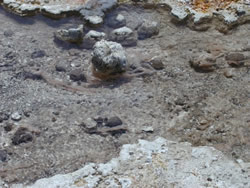Aquifex aeolicus
A Microbial Biorealm page on the genus Aquifex aeolicus
Classification
Higher order taxa
Bacteria; Aquificae; Aquificae (class); Aquificales; Aquificaceae
Species
Aquifex aeolicus
|
NCBI: Taxonomy |
Description and significance
Aquifex aeolicus is a chemolithotrophic bacterium that grows best at 95 degrees Celsius. It can be found near underwater volcanoes and is hyperthermophilic eubacterium (6). “It can grow on hydrogen, oxygen, carbon dioxide, and mineral salts” (1). It is rod-shaped, about two to six micrometers long and has a diameter of half a micrometer.
Aquifex aeolicus is a microaerophilic aerobe, and the byproduct of its respiration is water. Oxygen is the final electron acceptor of its respiration, and this “is allowed by the presence of a complex respiratory apparatus.” Aquifex pyrophilus can grow in environments with levels of oxygen as low as 7.5 ppm (1).
A. aeolicus was originally isolated by R. Huber and K.O. Stetter in the Aeolic Islands north of Sicily near underwater volcanic vents.
Genome structure
The genome of Aquifex aeolicus is about the third of the size of E. coli’s with 1,551,335 base pairs (1). Genomic redundancy is calculated to be 4.83 (Deckert et al. 1998). About 16% of its genes originated from Archea. It is one of the earliest diverging microbes in the Bacteria Domain. A. aeolicus has one DNA molecule, a circular chromosome. It has 43.47% G-C base pairing and 1778 genes, of which 97.18% (1728) code for proteins (2). “Many genes that are functionally grouped within operons in other organisms, such as the tryptophan or histidine biosynthesis pathways, are found dispersed throughout the A. aeolicus genome or appear in novel operons…A. aeolicus is extreme in that no two amino acid biosynthetic genes are found in the same operon. In contrast, genes required for electron transport, hydrogenase subunits, transport systems, ribosomal subunits, and flagella are often in functionally related operons” (1).
A single extrachromosomal element (ECE) is present in A. aeolicus. It has more redundancy than the chromosome, and sequencing shows great redundancy between the ECE and chromosome, suggesting genetic exchange between the two (1).
Cell structure and metabolism
A. aeolicus is chemolithotrophic, meaning it uses an inorganic carbon source for biosynthesis and an inorganic chemical energy source. It is autotrophic, and so it fixes CO2. It is does not form spores, is gram-negative and has a rod shape. A. aeolicus is about 2.0-6.0 micrometers in length and has a diameter of 0.4-0.5 micrometers. “The enzymes this organism uses for aerobic respiration are similar to the enzymes found in other aerobic bacteria.” A. aeolicus oxidizes hydrogen gas, and the final electron acceptor is oxygen in this process. The final product of its respiration is water, Aquifex meaning “water-maker” (1). However, Aquifex can reduce and fix nitrogen and sulfur as well as hydrogen, and, in sulfur and thiosulfate metabolism it produces sulfuric acid and H2S (8). However, A. aeolicus has not been shown to grow anaerobically on nitrogen like Aquifex pyrophilus (1).
“Aquifex aeolicus is a microaerophilic, hydrogen-oxidizing, hyperthermophilic bacterium containing three [NiFe] hydrogenases...The Aquifex hydrogenases are thermostable and tolerant to oxygen. A cellular function for the three hydrogenases has been proposed. The two membrane-bound periplasmic hydrogenases may function in energy conservation, whereas the soluble cytoplasmic hydrogenase is probably involved in the CO2 fixation pathway" (7).
A. aeolicus forms cell conglomerations consisting of up to 100 individual cells. It is motile, and possesses monopolar polytrichous flagella. Its chemotaxis system remains as yet unidentified, but since it is an obligate chemoautotroph and hyperthermophile, A. aeolicus may respond to changes in concentration of CO2, H2 or O2 and temperature (1).
Ecology
Aquifex aeolicus grows in extremely hot temperatures, such as near volcanoes and hot springs. It has been isolated in hot springs in Yellowstone National Park. It grows optimally at 80 degrees Celsius, but can grow in temperatures up to 95 degrees Celsius (1). It is microaerophilic, and Aquifex needs only 7.5 ppm oxygen for respiration. A. aeolicus can grow on hydrogen, oxygen, carbon dioxide, and mineral salts. Aquifex species generally form large cell aggregates, which can be comprised of up to 100 individual cells (1).
Pathology
There is no known pathogen among different strains of Aquifex aeolicus.
Application to Biotechnology
A. aeolicus may have many applications to the biotechnological field. It is unique in its resistance to heat and oxygen. This also would make it useful for improving industrial processes. “Aquifex aeolicus is a hyper-thermophilic eubacterium, which probably diverged at the earliest period from the other bacteria on the evolution of life. Therefore, analyses of RNA modification enzymes of this bacterium may supply important information in relation to the establishment of the early protein synthesis" (6).
“A. aeolicus hydrogenases are good candidates for biotechnological uses due to their high stability against oxygen and high temperature” (7).
References
1) Deckert G, Warren PV, Gaasterland T, Young WG, Lenox AL, Graham DE, Overbeek R, Snead MA, Keller M, Aujay M, Huber R, Feldman RA, Short JM, Olsen GJ, Swanson RV. “The complete genome of the hyperthermophilic bacterium Aquifex aeolicus.” Nature. 1998 Mar 26. p. 392(6674):353-8.
2) Aquifex aeolicus VF5 Genome Page
3) Fernandes AT, Soares CM, Pereira MM, Huber R, Grass G, Martins LO. FEBS J. 2007 Apr 19; [Epub ahead of print]
4) Chen B, Doucleff M, Wemmer DE, De Carlo S, Huang HH, Nogales E, Hoover TR, Kondrashkina E, Guo L, Nixon BT. Structure. 2007 April. p.15(4):429-440.
5) Jorgensen AM, Tagmose L, Jorgensen AM, Bogeso KP, Peters GH. ChemMedChem. 2007 Apr 13; [Epub ahead of print]
6) Takako Awai , Toru Takehara , Hiroshi Takeda , Hiroyuki Hori. Nucleic Acids Symp Ser (Oxf). 2005. p. (49):303-304 17150754
7) Guiral M, Aubert C, Giudici-Orticoni MT. Hydrogen metabolism in the hyperthermophilic bacterium Aquifex aeolicus. Biochem Soc Trans. 2005 Feb. p. 33(Pt 1):22-4.
8) Systems Biology Inc. http://www.systems-biology.org/001/kegg/aae.html.
Edited by student of Rachel Larsen and Kit Pogliano

